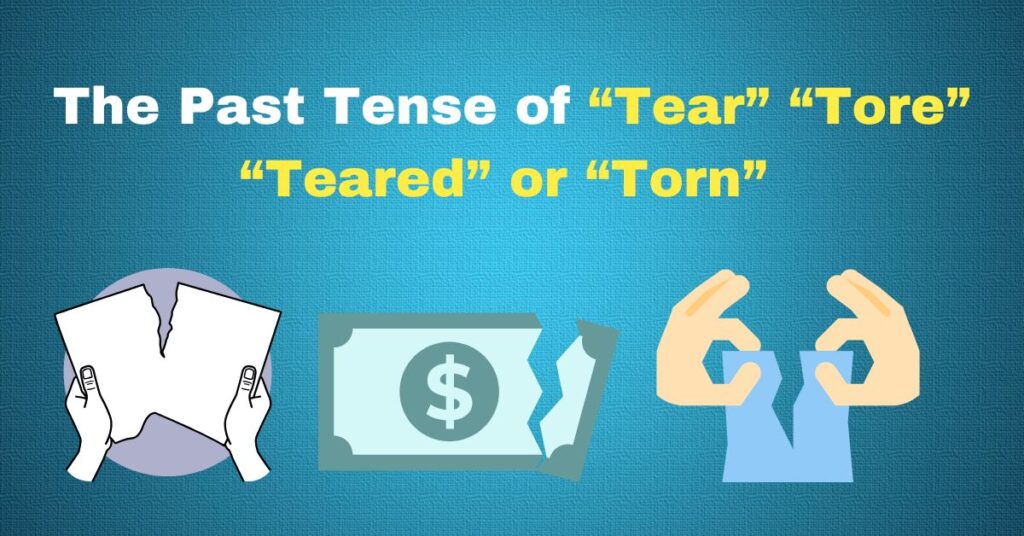The Past Tense of Tear Tore Teared or Torn? Learning English means grappling with its irregular verbs, and tear is no exception. The verb tear seems simple at first glance—until you try to figure out its past tense. Should you say “tore,” “teared,” or “torn”? Whether you’re writing or speaking, getting this right is important. In this article, we’ll clarify when to use “tore,” “torn,” and why “teared” is never a correct option. Let’s explore the world of tear and its past forms.
Definition
The verb tear is one of those irregular verbs that doesn’t follow the usual rules for forming past tenses. It has two primary meanings:
- To rip or break something (like paper or fabric) by pulling it apart with force.
- To shed tears (as in crying).
Understanding the various forms of tear is key to mastering English grammar.
| Verb Form | Tense | Example |
| Tear | Base form (present) | “I always tear the paper when I write too fast.” |
| Tore | Past tense | “He tore his shirt while playing football.” |
| Torn | Past participle | “The paper has been torn into pieces.” |
| Tearing | Present participle | “She is tearing the letter into small pieces.” |
Meaning & Explanation
Tore: The Past Tense
- The past tense of tear is tore, used to describe actions completed in the past.
For example:- “She tore the paper when she got frustrated.”
- “I tore the wrapping paper to open the gift.”
This form clearly shows that the tearing action happened at a specific moment in the past.
Torn: The Past Participle
- The past participle form of tear is torn. You’ll typically see it used with auxiliary verbs like have, has, or had.
Examples:- “The letter has been torn into pieces.”
- “The fabric had already torn when I found it.”
“Torn” suggests an action that occurred prior to another event or is still relevant to the present moment.
Teared: The Common Mistake
- Teared is a mistake that many English learners make. It is not a correct form of tear. Always use “tore” for the past tense and “torn” for the past participle.
- Incorrect: “She teared the paper into pieces.”
- Correct: “She tore the paper into pieces.”
Remember: teared doesn’t exist!
Examples & Usage
Let’s break down the different forms of tear in real-life sentences. We’ll cover both the physical and emotional meanings of the verb.
Examples of Tear in Sentences
| Verb Form | Example |
| Tear | “I always tear the paper when I write too fast.” |
| Tore | “He tore his shirt while climbing over the fence.” |
| Torn | “The paper has been torn by the heavy rain.” |
| Tearing | “She is tearing the letter into small pieces.” |
Using Tear to Talk About Crying
When tear refers to crying, the conjugations still apply in the same way. Here are a few examples:
- Tear: “She tears up every time she watches that sad movie.”
- Tore: “He tore up during the funeral.”
- Torn: “Her eyes were torn from crying too much.”
Types & Categories
| Verb Form | Tense | Usage |
| Tear | Present tense | Refers to the current action of tearing something. |
| Tore | Past tense | Describes the action of tearing completed in the past. |
| Torn | Past participle | Used with auxiliary verbs to describe an action before now. |
| Tearing | Present participle | Describes an ongoing action or a habitual action. |
Related Words & Synonyms
While “tear” is quite specific, there are several synonyms and related words that may be used depending on context. Here’s a list to consider:
- Rip
- Shred
- Rend
- Fray
- Slice
- Split
- Cleave
- Damage
These synonyms can often be used interchangeably with tear, but keep in mind their subtle differences. For example, “rip” is often associated with quick or forceful tearing, while “shred” refers to tearing something into small, often thin, pieces.
FAQ Section
1. Is “Teared” a correct form of “Tear”?
- No, “teared” is never a correct form of tear. The correct forms are “tore” for the past tense and “torn” for the past participle.
2. What is the past tense of “tear” when referring to crying?
- The past tense of tear when referring to crying is still “tore”. For example:
- “She tore up during the emotional scene.”
3. Can “torn” be used in the present tense?
- No, “torn” is a past participle and is used with auxiliary verbs like have or had. For the present tense, the correct form is “tear” or “tearing”.
4. What’s the difference between “tore” and “torn”?
| Form | Usage | Example |
| Tore | Simple past tense, used to describe an action completed in the past. | “He tore his shirt while playing.” |
| Torn | Past participle, used with auxiliary verbs such as have or had. | “The paper has been torn into pieces.” |
Conclusion
The Past Tense of Tear Tore Teared or Torn? Mastering the past tense of tear is important for speaking and writing correctly in English. To recap:
- “Tore” is the correct past tense form.
- “Torn” is the correct past participle.
- Never use “teared”, as it is incorrect.
By keeping these rules in mind and practicing them in real-life sentences, you’ll be able to use tear confidently in any situation. Now, you’re one step closer to mastering this tricky irregular verb!
What is the Plural of Chief Chiefs or Chieves?






